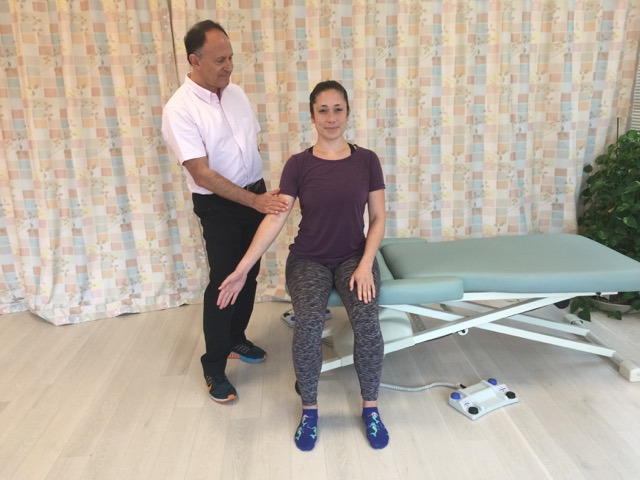Signs and Symptoms of Rotator Cuff Pathology:
The most common symptoms of rotator cuff pathology are pain, joint crepitus (e.g., clicking or clunking noise), weakness, and decreased range of motion when moving the shoulder (glenohumeral; GH) joint. Another common symptom is hypertonicity, in other words global tightness of the rotator cuff muscles and/or myofascial trigger points (TrPs) in the rotator cuff muscle. The degree of each of these symptoms varies with the degree of the pathologic injury to the tendon. The location of the symptoms varies based on which muscle’s tendon of the rotator cuff tendon is injured. Which range of motion is decreased also varies base on which rotator cuff tendon is injured.
The symptoms of rotator cuff tendinitis and a rotator cuff tear are similar; however, as a general rule, a tear will be accompanied by more joint crepitus than tendinitis will. When a tear is present, often a loud popping or clunking noise is heard and felt when the client attempts movement. A complete tear that entirely ruptures the tendon is usually the most severe pathologic rotator cuff condition and often results in a total or near total loss of range of motion (either abduction, lateral rotation, or medial rotation depending on the muscle/tendon unit ruptured).
Assessment/ Diagnosis of Rotator Cuff Pathology:

Manual resistance to glenohumeral joint scaption (abduction with flexion) to assess rotator cuff pathology. Permission: Joseph E. Muscolino.
The primary method of orthopedic assessment/diagnosis for a pathologic tendon is active contraction of its muscle belly. Contraction of its belly creates a tensile force on the tendon; if the tendon is injured, this tensile force should elicit symptoms, such as pain, crepitus, and weakness. Muscle contraction can be created by active (concentric contraction) range of motion or manual resistance (isometric contraction). For the rotator cuff, the principle ranges of motion to assess are abduction (or an oblique plane motion combining abduction with flexion in the plane of the scapula – scaption; approximately 30-35 degrees off the frontal plane toward the sagittal plane in an ideally positioned scapula) for the supraspinatus, lateral rotation for the infraspinatus and teres minor, and medial rotation for the subscapularis.
Stretching the injured rotator cuff tendon will also elicit symptoms (especially pain) in pathologic tendon. Therefore, passively moving the patient’s/client’s arm in the antagonistic motion to the injured tendon is also valuable for diagnosis/assessment (for example, passive medial rotation would elicit symptoms in the infraspinatus and/or teres minor).
To assess for hypertonicity in the rotator cuff musculature, passive range of motion and palpation are the most effective assessment tools. If hypertonicity is present, passive motion in the opposite direction would be limited. For example, tightness in the teres minor, a lateral rotator, would result in decreased medial rotation range of motion of the GH joint. Palpation is effective for the assessment of global tightness and myofascial trigger points in the musculature, as well as inflammation of the tendons. Inflammation would be palpated by the presence of heat and swelling. It is usually not possible to palpate and feel tendon degeneration.
Medically, a pathologic rotator cuff tendon is usually assessed by MRI study. MRI with contrast medium is especially effective for assessment of a rotator cuff tear. An X-Ray is not an effective assessment procedure for a pathologic rotator cuff because X-Rays only show bones.
Differential diagnosis/assessment of rotator cuff pathology:
There are a number of conditions that should to be differentially diagnosed/assessed when it is suspected that a client/patient has a pathologic rotator cuff tendon. One is a bone spur on the underside of the acromion process, or other degenerative arthritic changes in the GH joint. Bone spurs and other arthritic changes are easily identifiable on X-Ray. Two other conditions that may cause symptoms similar to rotator cuff pathology are a tear of the glenoid labrum and subacromial bursitis; these conditions are best assessed by MRI. Note: Subacromial (also known as subdeltoid) bursitis usually accompanies tendon pathology of the supraspinatus because they travel together between the head of the humerus and the acromion process of the scapula.
One other condition that can mislead a therapist to believe that the client/patient has a pathologic rotator cuff tendon is hypertonicity in the rotator cuff musculature or other GH joint musculature. Differentially assessing rotator cuff hypertonicity from rotator cuff tendon pathology is more challenging because hypertonicity of shoulder joint musculature is usually also part of rotator cuff pathology. Therefore, if shoulder muscle hypertonicity is found, it is still necessary to rule in or rule out rotator cuff pathology.



